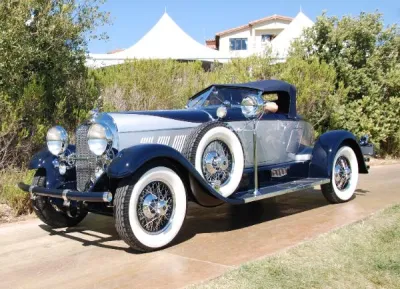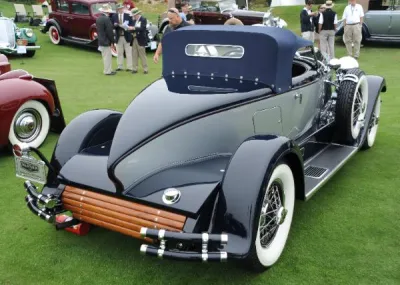

The bold styling of the Auburn Boattail Speedster epitomized the era known as the roaring twenties. Women won the right to vote, Prohibition began, the Charleston was the newest dance craze, Lindbergh flew across the Atlantic and the Academy Awards debuted.
The Auburn Automobile Company was founded in 1903 and ceased manufacturing automobiles in 1937. During its 34 year history its financial performance would best be described as tumultuous. Despite the economic effects of the Great Depression the company experienced periods of strong sales followed by years of dismal operating results.
In 1924 the Board of Directors of the Auburn Automotive Co. hired E.L. Cord to “turn the company around.” Cord
had considerable experience as an executive for the Moon Automobile Co. Cord restructured the sales and
distribution functions of the Auburn Automobile Co., resulting in increased sales and profits. The Board of Directors in 1926 sold the company to Mr. Cord. At this time the assets of the bankrupt Duesenburg Motor Co. were merged in to Auburn Automobile Co. In addition a new marque, “Cord” was introduced.
The Auburn Automobile Company experienced its best year in 1929, just prior to the Stock Market Crash. Its
sleekest model was the 8-90 Boattail Speedster. In the Model 8-90 Auburn offered a straight-eight at prices putting it within reach of thousands of people who had previously paid more for six-cylinder cars not comparable in size or performance. More then 2,000 of the two-seater speedsters with the boat tail-shaped rear-end were sold. An eight-cylinder, 248 cubic inch Lycoming engine that produced 93 horsepower powered the Auburn 8-90 series.
Neither the Auburn Boattail Speedster nor the revolutionary 1936-37 Cord models 810 and 812 were able to
generate the necessary level of sales to keep the company afloat. At the end of 1937 the Auburn Automobile
Company ceased manufacturing automobiles.
